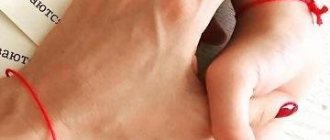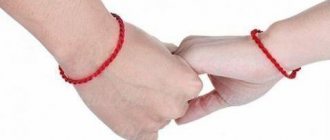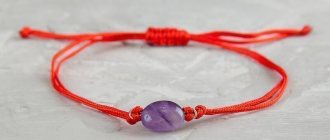Is the red thread a “panacea” for the evil eye? [↑]
Today you can often see a red thread tied to a child’s arm, leg, or stroller. Some believe that the red thread can ward off the ain aRa (evil eye, evil eye) from a person.
The question of whether the red thread is a “panacea” for the evil eye or not is what this article will be devoted to.
But, before we move directly to the red thread, it is worth noting that the use of red dye or red thread is mentioned more than once in Jewish sources.
What should be the thread for the amulet: material, appearance
Traditionally, Kabbalah notes that an Israelite amulet should be made only from woolen thread . The beneficial properties of this material were also noted by the ancient Slavs, and were also confirmed by medical specialists. Wool contains lanolin, which has a beneficial effect on the body: relieves joint pain, inflammation, has a beneficial effect on the skin, and heals wounds. In addition, static electricity generated between the fibers improves blood circulation.
All practices and beliefs, except Kabbalah, allow the use of natural materials such as linen and silk, but they are considered much less effective and are rarely used. The thread should be chosen only in a red shade. According to many beliefs, it symbolizes protection and strength. This tone also provides relief from everyday passions, replenishment of energy, resolution of financial issues, attraction of the opposite sex and the birth of offspring.
Red wool thread in Temple times [↑]
The Torah (Pentateuch) mentions the so-called several times. "tolaat shani"
- a thread or piece of wool dyed in a color close to red.
There are several opinions on how the paint for tolaat shani
, and we will talk about this a little below.
Tolaat Shani paint
used in the following commandments:
1. Some of the Mishkan coverings were woven using thread dyed in tolaat shani:
“And thou shalt make the Mishkan of ten curtains of fine woven linen, and blue, and scarlet, and
scarlet
(
וְתֹלַ֣עַת שָׁנִ֔י
)” (
Shemot 26:1
).
2. The same thread was used to create parochetes
- a curtain covering the entrance to the Holy of Holies, both in the Mishkan in the desert and in the Temple of Jerusalem (
ibid., 26:31
).
3. In the robes of the high priest: ephod
(ibid., 28:6);
hoshen
- breastplate (
ibid., 28:15
);
avnet -
belt
(ibid., 39:29
);
pomegranates on the hem of the high priest's outer garment ( ibid., 28:33
).
4. This dye is mentioned in the preparation of the ashes of a red cow ( Bamidbar 19:6
).
5. Also used in the process of cleansing someone who was sick with the leprosy-like ulcer of tsaraat
(
Vayikra 14:4
).
6. The sages used this dye to color a ribbon that was tied to the horn of a special scapegoat - one of the types of sacrifices on Yom Kippur.
7. Also on Yom Kippur, a red ribbon was hung on the rock to be a sign of atonement for sins: when it turned white, it was a symbol that repentance had been accepted and the sins of the people had been atoned for.
Origin and color of tolaat shani paint [↑]
When describing this paint, commentators from different eras used words of Aramaic origin - zeorit tova
.
True, this color could be called bright red paint of any origin. It could be obtained from plants, fish and shellfish. And for the above commandments, you can only use one
that comes from one specific type of living organism - just as they did in the times of the Mishkan and the Temple.
The modern translation of the word " tolaa" is
worm.
However, many modern researchers argue that talaat shani
is not a worm, but an aphid. This insect lives in trees and feeds on red berries, which gives its body a red color.
Others claim that the dye is obtained not from the body of the red aphid itself, but from the red fruits on which it is found. After all, it cannot be that something unclean is used to produce the elements of the Mishkan!
However, many commentators believe that the prohibition on the use of unclean animals and insects for the regalia of sanctity applies only to the materials from which Torah scrolls, tefillin and mezuzahs are made.
According to another opinion, if the paint made from unclean insects is intended for consumption, only then is it prohibited to paint elements in the Mishkan with it. It turns out that, in principle, it is theoretically possible to use paint obtained from aphids or worms for services in the Temple.
Thus, we see that, unfortunately, we do not have a clear tradition regarding this insect, and there are no sources from the eras of the First and Second Temples.
Using pendants
According to the traditional ideas of Kabbalah, a red woolen thread is a powerful amulet in itself and does not require the additional use of any pendants. If the owner does not adhere to the views of this practice, he can enhance the effect of the amulet with the help of any amulets of similar purpose. It can be:
- hand of Fatima;
- nazar;
- Dzi beads (for example, Green Tara, Lotus, Garuda, Turtle, with 7, 8, 18 or 12 eyes);
- star of David;
- pin;
- horseshoe;
- figurine of an owl or fish;
- Slavic symbols (Alatyr, shield of Perun, etc.);
- rune signs (for example, Algiz, Eyvaz, Berkana, Hagall).
Aphids of the carmilim family[↑]
Let us separately mention the opinion of many commentators that tolaat shani
also found in the TaNaKh under the name
carmin
, as it is said: “And he made a curtain of (fabric) blue, and purple, and
carmel
(
וְכַרְמִ֣יל
) and fine linen, and depicted the Kerubim on it” (
Divey Ha-Yamim 2, 3:14
).
As already mentioned, today no one can say with certainty that they are familiar with the secret of preparing tolaat shani
.
However, in the Land of Israel there are aphids that live on oak trees and belong to the carmilim
. This insect reproduces by laying red eggs. When her eggs reach their maximum size, about the size of a pea, they are collected.
Is it possible to remove it yourself?
Israeli thread requires constant contact with the owner, so it is used until it completely loses its physical properties. Typically this period is 2-3 months. You cannot untie or remove the amulet to go to the bathhouse, plant in the garden or clean up.
In the case where the amulet retains its physical integrity, but the owner wants to remove it from his hand due to severe contamination, persistent foreign odor, or unkempt appearance, this can be done. The only condition is a ban on re-using the same amulet, even if it has been cleared. A removed amulet cannot be put on again.
The knots are not unraveled; the thread should be cut with scissors or a knife. It is also permissible to get rid of the amulet on your own if your intended wish is fulfilled or if you are cured of an illness.
Paint color tolaat shani [↑]
Just as we do not have a clear tradition about the production of paint, we do not have clear evidence of what the color and shade of this paint is. And only in the era of Rishonim
the first descriptions appear.
Thus, in the translation of the Torah into Aramaic “Targum RaSaGa”
(RaSaG - Rav Saadya Gaon), every time
tolaat shani
, it is translated as paint
karmaz
.
Yosef Matityahu
writes that this paint is the color of fire. But the flame of a fire can have different shades! What shade do you mean? From multiple sources it follows that this color is not quite red, but orange, like an orange.
Also in Arabic the word karmaz
, which means not a strong red color, but a weak red color.
argaman was present in the robes of the high priest and in the elements of the Temple
, and about him we know for sure that his shade was scarlet.
And, since the paints were made for the beauty and grandeur of the Mishkan
and the Temple, it is possible to assume that
tolaat shani
was not a repetition of another color or shade, but was an independent shade.
The custom of tying a red thread on a hand [↑]
Today it is a very common custom to wear a red thread on the arm. Also, many mothers knit a red thread on their children’s strollers, which, according to the mistaken belief, can protect against the evil eye. Where does this custom come from?
It is possible that on Yom Kippur a red ribbon was tied to the horn of a scapegoat, and another was tied to a rock as a symbol of forgiveness of sins - this could become a prototype of the modern custom.
It is possible that the source for this was an interesting story that occurred before the seizure of the Holy Land during the time of Joshua bin Nun.
The book of Joshua tells that before the capture of the city of Yericho, Joshua bin Nun sent two scouts there. The scouts ended up in the house of Rahab, who hid them. Before the scouts left her home, Rahav asked that she and her loved ones not be killed during the assault on the city. The red thread became this sign - the scouts answered her like this: “Here, we are coming to this land, you are this cord made of scarlet threads.”
(
חוּט֩ הַשָּׁנִ֨י
) bind us to the window through which you let us down, and gather your father and your mother and your brothers and all your father’s family into your house” (
Joshua 2:18
).
There is a common belief that these spies were Caleb, son of Jephune, and Pinhas, son of Elazar. However, in Midrash HaGadol
it is said that these were the sons of Judah and Tamar - Perez and Zerah.
It is told about Zerah in the Torah that at the hour of his birth, the midwife who delivered the birth tied a red thread on his hand:
a
red thread on his hand ,
saying: this one came out first”
(
Genesis 38:28
).
Thus, the midrash easily answers the question “how and why did the scouts have the red thread at hand at the right moment?” After all, it is possible that such paint was not cheap to produce and was considered expensive at that time. According to this midrash, Zerah gave Rahab the exact red thread that the midwife tied on his hand at the time of his birth - because, of course, he always carried this thread with him.
Select and tie the thread correctly
Those who want to get the maximum effect from a wool amulet should choose only those threads that were brought from Israel and charged at Rachel’s tomb. It is believed that you should not take an amulet from the giver, it will not bring any benefit, you must buy it yourself.
If it is not possible to purchase a sacred object directly in its homeland, then you can find it in esoteric shops or online stores, be sure to check the barcode for the country of origin, or buy wool and speak it yourself.
Only someone who is close to the owner and has exclusively sincere and positive feelings for him should tie the thread.
This could be a relative, close friend or spouse. It is also permissible for a spiritual teacher or mentor to do this. Kabbalah does not allow tying knots on your own; other religions and practices do not impose such a ban.
To attract good luck
A correctly tied Jerusalem thread attracts good luck to the owner. He begins to feel with whom it is better to establish relationships and who to ignore, which transactions will be successful and bring maximum profit. The owner begins to see the optimal way out of any situation. The owner of the amulet will have good luck in the financial sphere, when communicating with people, learning, finding a mate and other areas.
To attract good luck, according to the traditions of Kabbalah, you should wrap a thread once around your left wrist, tie 7 knots , reading a spell for each of them. The remaining ends of the wool amulet must be scorched with fire; they cannot be cut off. According to Slavic traditions, the amulet is placed not on the left, but on the right wrist. Buddhist traditions recommend tying 9 knots, not 7.
From the evil eye and damage
To protect yourself from the influence of negative forces, envy, and the flow of negative energy, you should wear a red woolen thread. It is tied only to the left hand, because, according to popular belief, it is the hand that is responsible for the receipt of any type of influence from the outside. The amulet is wrapped around the wrist, so that about 2 cm , the traditional 7 knots , accompanied by reading the plot.
For the fulfillment of desires
The Jerusalem amulet can make any deepest desire come true. The main condition for its implementation is that the owner sincerely believes in the performance. A red thread is tied around the left wrist and closed with 7 knots . During the procedure, you need to focus on your desire, trying to put your idea into the talisman.
To protect your health
The amulet helps maintain health, improve immunity, and get rid of existing ailments. In addition, it is believed that wool, due to its properties, can relieve joint pain and inflammation. There are 2 ways to use the Jerusalem amulet to protect health:
- tied on the left hand and secured with 7 knots;
- wrapped around the sore joint.
For a child
Newborns do not have protection from the evil eye; as they grow older, it appears, but while the children are small, it remains weak. Therefore, it is important to protect children from the influence of evil forces. To do this, the mother or grandmother puts an amulet on the child’s left hand, tying knots and reading a spell (or pronouncing wishes) for each.
The Slavs even put a red thread on the wrist of newborns. The amulet protects against damage and the evil eye and preserves health.
Is it possible to tie a red thread on your hand today? [↑]
There are many opinions expressed regarding the custom of knitting a red thread on a hand or on a baby stroller. This is due to the fear that whoever knits a red thread on his hand, as a panacea for troubles or the evil eye, violates the prohibition “Do not act according to the customs of the Emorites.”
.
What does this ban include?
"Customs of the Emorites"
is a collective concept that combines the customs and laws of the peoples of the world, the basis for which was stupidity or prejudice.
And the source of the prohibition is learned from the verse of the Pentateuch: “You shall not walk according to the customs of the land of Egypt, in which you dwelt, and you shall not walk according to the customs of the land of Canaan, where I am leading you, and you shall not walk in their statutes” ( Vayikra 18:3
) .
Examples of the customs of the Emori people are given in the Shabbat of the Talmud and in the Tosefta.
. To understand what we are talking about, here are some of them:
- the one who says: “I will drink wine, but leave it,” so that there is a blessing in the wine;
- the one who heard that a raven croaked and said: “shut up, turn your tail towards me, that the croaking was for good”;
- the one who orders the slaughter of a rooster because it seemed to him that he was croaking like a raven;
- the one who relieves himself in front of the pan so that the brew cooks faster;
- one who places burning candles on the ground to make the dead feel bad;
- the one who prohibits the installation of burning candles, which was not bad for the dead;
- one who asks to immediately pick up a piece of bread that has fallen out of his mouth (a bad omen);
- the one who knits a scarf on his hip and a red thread on his finger...
And many more examples.
There are commentators who believe that the ban applies only to those cases listed in the Babylonian Talmud.
However, according to most opinions, the examples given there are only prototypes
, giving an idea of various stupid customs in our days. Accordingly, stopping movement on the road if a black cat crossed the road, tying a red thread on your hand, and the like, fully falls under the prohibition not to walk the paths of the Emorites.
And one of the greatest Torah sages of our time - Rabbi Chaim Kanevsky - directly answered that he would not advise anyone to knit a red thread, either on a child’s stroller or on his own hand.
What will really help against the evil eye [↑]
If you, however, are concerned that you are still under the influence of some sinister forces, you can turn to other, more proven methods. We do not have information about whether the red thread helped anyone. But, of course, it cannot serve as a substitute for sincere prayer, charity and moral behavior.
Of course, it is easier and “cheaper” to simply buy a red thread, but, unfortunately, this action will not make the world a better place. But if we increase the impact of positive energy by doing good deeds, selflessly helping others and rejoicing in their successes, we not only “repel” ain aRa, but also actively fight the influence of bad forces in this world, reducing it.
For those who lead a meaningful lifestyle, for whom “charity” and “caring for others” are not an empty phrase, the red thread is nothing more than a tourist souvenir.
How to make a talisman yourself: instructions
A classic amulet made from red thread is easy to make yourself. To do this, you need to take wool fibers blessed in Israel, or buy similar ones in tone at a handicraft store. The wool must be natural, without impurities. Instructions for creating an amulet :
- Wrap the thread around your wrist.
- Place the right tip under the left, lift it up and thread it into the “loop” formed. This “knot” is not counted, because serves only for fixation.
- Pull it to the size of your wrist, leaving about 2 cm to the skin.
- Pass the tip, which is currently the right one, under the left one, lift it up and thread it into the “loop”.
- Tighten tightly while reading the plot. This node will be considered the first.
- Tie 6 more knots, each time reading the spell or expressing a desire.
- Melt the excess ends of the wool thread with fire.
The knot can be made using another technique, the main thing is to tie the required amount, put your energy and meaning into the amulet.











